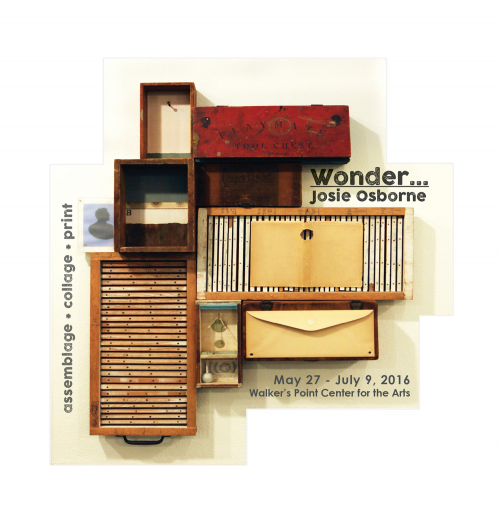Josie Osborne: Wonder… & Gary John Gresl: Anthropocene Culminatus
Exhibition Date: May 27 – July 9, 2016
Joint Reception: Saturday, June 11, 5–9 pm
Joint Art Talk: Wednesday, June 29, 5:30–8 pm
We are honored to announce two concurrent solo exhibitions of esteemed Wisconsin artists Josie Osborne and Gary John Gresl. A joint reception will be held on Saturday, June 11 from 5 to 9 pm. An ‘Art Talk’ featuring the two artists will be held on Wednesday, June 29 from 5:30 to 8 pm.
Both exhibitions open on Friday, May 27 and runs through July 9, 2016.
The tie-in between Anthropocene Culminatus and Wonder…
Although these are two separate exhibitions, there are a lot of similarities between the two. Both Josie’s and Gary’s work reference a tradition of creating artwork with found and readymade objects with their own signature that provide personal narrative and expression.
Josie Osborne: Wonder…
Wonder can be awe inspiring or perplexing, or both at once. Josie Osborne’s assemblage, collage and print work in this solo exhibition exude capricious playfulness and encourage the audience to be inquisitive. Found and readymade objects create ensembles of tactful and figurative narratives. Repurposed wood containers, pages from old books, bookbinding threads, beeswax, type drawers, flower and bird motifs are items used repeatedly throughout the exhibition. Many items reference Osborne’s practice and scholarship in printmaking.
Josie Osborne is a visual artist, lecturer and the Director of the First Year Program in Art and Design at UW-Milwaukee’s Peck School of the Arts. She served on the City of Milwaukee Arts Board and has received a Mary Nohl Suitcase Fund support for a traveling exhibition and international studio residency. Osborne has exhibited extensively and curated numerous exhibitions. She received a Masters of Fine Arts in Graphics (printmaking) from the University of Wisconsin – Madison and a BFA in Painting and Drawing from UW-Milwaukee.

Gary John Gresl: Anthropocene Culminatus
Using largely rustic materials drawn from rural environments or objects aged, weathered, altered and evolved by and in nature, Anthropocene Culminatus is presented as a site specific, one time manifestation and not to be created again in this same composition.
Anthropocene defines the Earth’s timeline in which Humanity has exerted enough influence to alter the natural conditions. Culminatus suggests in Latin the word culminates. Together they describe a decaying natural environment exacerbated by man-made influence. Anthropocene Culminatus not only prescribes a dire descent of the natural environment in the dominance of human civilization, but also the cycle of life and death depicted by the installation as a whole, assembled with curious and seemingly arbitrary objects portraying the beauty in the face of rustic decay.

Gary’s statement: I use of natural/organic/weathered/evolved materials is an outgrowth of formative stages of his life when I spent time in rural environments, woodlands, lakes, farms, abandoned neglected buildings. I am interested I bringing the organic and rural and overlooked materials into “white spaces”. There is beauty in disintegration and evolved objects.

